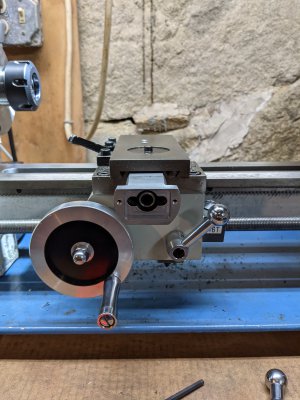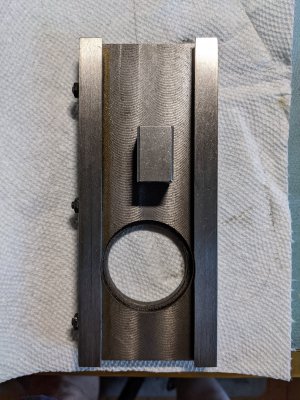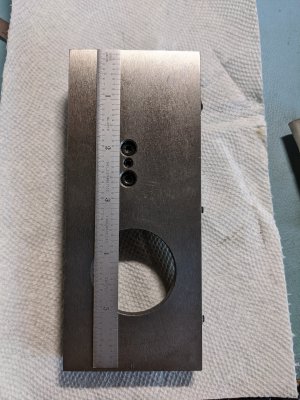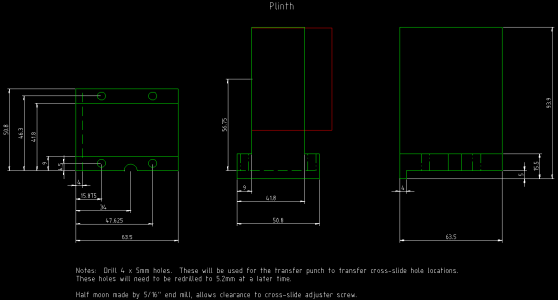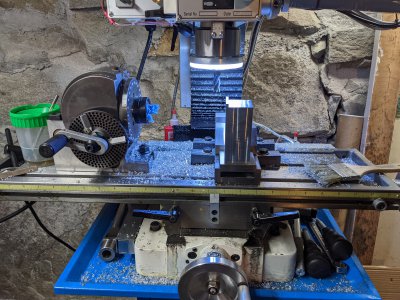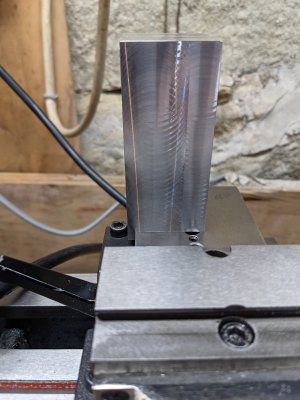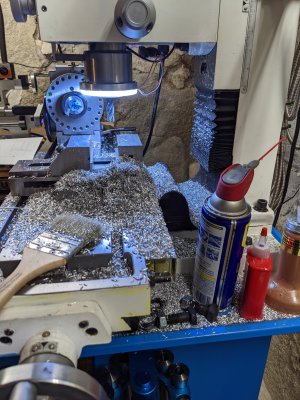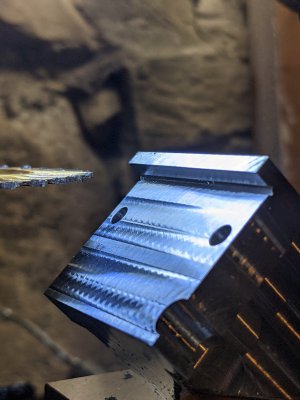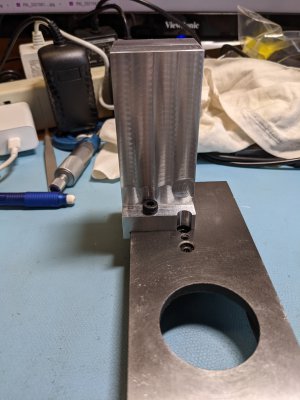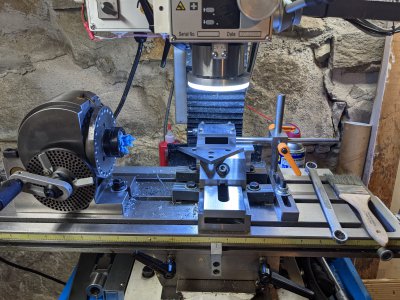- Joined
- Dec 18, 2019
- Messages
- 6,441
Small flurry of activity. In the morning made a shoulder washer. Managed to hit 0.2498" with a target of 0.2495" A little snugger, but it fits nicely in the reamed hole. Shoulder came out a little thinner that I wanted, because I forgot I needed to clean up the parted workpiece. It's 0.037" so it is still ok. Drilled out the hole with a #14 and #13 drill. Unfortunately, a #13 is not quite big enough to pass a 10-32 screw. I used the stubby drills in the lathe. After a couple of tries and fitting the bushing to the pieces, I finally managed to get the length ok. I have mounted a dial indicator on my lathe, but it fouls with the compound when I set it at 6 degrees. I used the 6 degree setting so I would get 0.1 mill in Y for every 1 mill in the compound. Made it a lot easier to sneak up on the diameter. But the compund postion required I move and reset the indicator a lot more than I would have liked. It would be better to get a 2" travel indicator. Lunch came and I had to do some errands with my wife.
When we came back, my order from McMaster had arrived. Got a handful of stubby drills, some spiral point taps, and a #12 stubby drill. The #12 drill makes a hole just big enough for a 10-32 to make it through. So I immediately drilled out the bore of the shoulder washer. Then I made the second shoulder washer. I didn't quite make the second one as nice as the first. I really was trying for 0.2498 again, but I was satisfied with 0.2495, which was what Mikey specified in his plans. Was psyched that the pins were done, so I switched to the mill and tapped the 10-32 holes. At this point, I really wanted to see more of this assembled. Found a spring, the delrin washer I turned, the nut I made, and all the other pieces and assembled it. Naturally the first time I put it together it was sort of backwards. Took it apart again and reassembled it the right way.
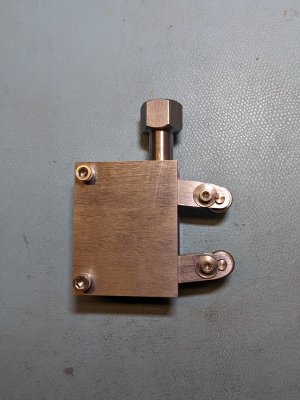
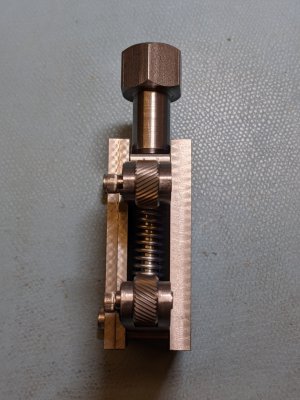
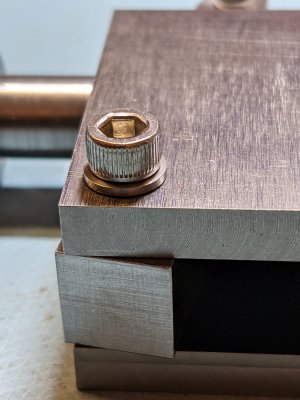
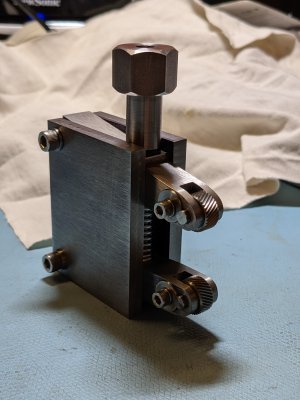
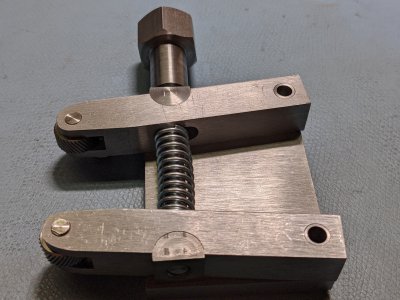
I need to make the internal plate spacers and to drawfile the plates slightly. When the 10-32 screws are fully tightened the arms are tight. I don't like the spring I got, I need to get something with thinner wire, as I get coil bind. Also for the nut, I think I drilled out too many of the threads. I could make another one later. I run out of threads at larger openings. Looking at the last picture I think the bottom shoulder pin is not quite long enough. The head is thicker, so I could make the body a little bit longer. Will have to grind a new HSS tool to do it. There's lots of clean up on this to do, polish it, shorten the bottom knurler pin so it looks like the top on, and just make it look a little nicer. Not unhappy with it, more amazed that I've gotten this far.
Was looking at my lathe as how to mount this. I think I will make a plinth, for a rear mount. My mini-lathe does not have any t-slots. So, I will have to disassemble the cross-slide to look underneath it to find a safe place to drill and tap the cross-slide.
When we came back, my order from McMaster had arrived. Got a handful of stubby drills, some spiral point taps, and a #12 stubby drill. The #12 drill makes a hole just big enough for a 10-32 to make it through. So I immediately drilled out the bore of the shoulder washer. Then I made the second shoulder washer. I didn't quite make the second one as nice as the first. I really was trying for 0.2498 again, but I was satisfied with 0.2495, which was what Mikey specified in his plans. Was psyched that the pins were done, so I switched to the mill and tapped the 10-32 holes. At this point, I really wanted to see more of this assembled. Found a spring, the delrin washer I turned, the nut I made, and all the other pieces and assembled it. Naturally the first time I put it together it was sort of backwards. Took it apart again and reassembled it the right way.





I need to make the internal plate spacers and to drawfile the plates slightly. When the 10-32 screws are fully tightened the arms are tight. I don't like the spring I got, I need to get something with thinner wire, as I get coil bind. Also for the nut, I think I drilled out too many of the threads. I could make another one later. I run out of threads at larger openings. Looking at the last picture I think the bottom shoulder pin is not quite long enough. The head is thicker, so I could make the body a little bit longer. Will have to grind a new HSS tool to do it. There's lots of clean up on this to do, polish it, shorten the bottom knurler pin so it looks like the top on, and just make it look a little nicer. Not unhappy with it, more amazed that I've gotten this far.
Was looking at my lathe as how to mount this. I think I will make a plinth, for a rear mount. My mini-lathe does not have any t-slots. So, I will have to disassemble the cross-slide to look underneath it to find a safe place to drill and tap the cross-slide.


